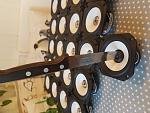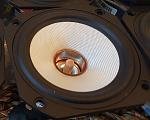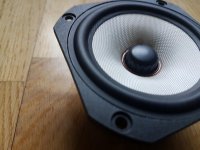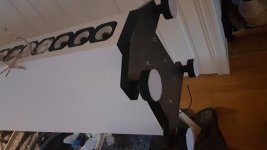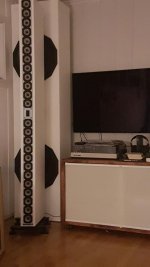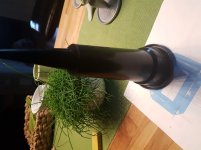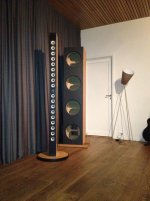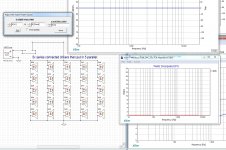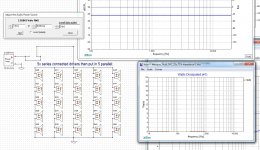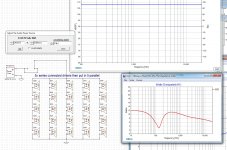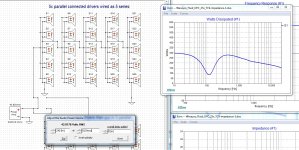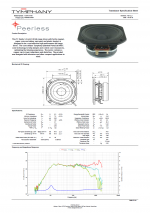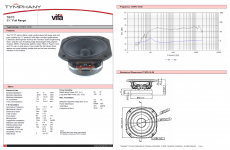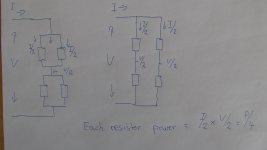Inspired by Roger Russels pretty IDS-25, I finally built my own towers.
DIY'er "5th element" generously shared his impressions, tweaks and measurements with me regarding VifaTG9.
He pointed out that3d. and 5th harmonic distortion raise quite a lot from 500 hz and down. The void under the cap is a relative big chamber in front of the 6mm "pipe". The cure was to add phase plugs.
The solution was some volum knobs( for guitar) spray painted with Plasti-Skin (same as PlastiDip) and wooden spline dowels 30x 6mm with a drop of glue, just to secure. Luckily, both the knobs and dowels dias are 6mm, fitting the hole in pole piece precisely. In other words: Mostly Lego. Knobs are plastic, not disturbing any field.
All TG9 (4 ohm) got its own chamber, 4,7 liters each. Compartments are separated by 6mm gypsum fiber-sheet (rehab plaster).
Full range? Mostly.I will experiment with chime-in tweeter.
I doubt there is such a thing as high end 3,5" cone tweeters, so I added AMT tweeters from Aurum Cantus (Oscar JAS) . Tweeters are modified with flat faceplate and damped conical back chamber from graveyard vase.
Sub woofers are 21" Hipower Pro BR-tuned to 18 hz in room. Magnet is dia 13". Not easy to handle in workshop.
Baseplate for towers are 25mm Alu with EPDM rubber dampers (from domestic AC accessory) and ice hockey pucks with felt. This make it easy to push the speakers in position.
Speakers are CNC machined and painted with paint meant for floors and stairs. Nylon elastics on baffle inspired from Sonus.
For tuning I use Dirac Live and crossover by MiniDSP. Tuning is ongoing.
WAF? I'm happily married
DIY'er "5th element" generously shared his impressions, tweaks and measurements with me regarding VifaTG9.
He pointed out that3d. and 5th harmonic distortion raise quite a lot from 500 hz and down. The void under the cap is a relative big chamber in front of the 6mm "pipe". The cure was to add phase plugs.
The solution was some volum knobs( for guitar) spray painted with Plasti-Skin (same as PlastiDip) and wooden spline dowels 30x 6mm with a drop of glue, just to secure. Luckily, both the knobs and dowels dias are 6mm, fitting the hole in pole piece precisely. In other words: Mostly Lego. Knobs are plastic, not disturbing any field.
All TG9 (4 ohm) got its own chamber, 4,7 liters each. Compartments are separated by 6mm gypsum fiber-sheet (rehab plaster).
Full range? Mostly.I will experiment with chime-in tweeter.
I doubt there is such a thing as high end 3,5" cone tweeters, so I added AMT tweeters from Aurum Cantus (Oscar JAS) . Tweeters are modified with flat faceplate and damped conical back chamber from graveyard vase.
Sub woofers are 21" Hipower Pro BR-tuned to 18 hz in room. Magnet is dia 13". Not easy to handle in workshop.
Baseplate for towers are 25mm Alu with EPDM rubber dampers (from domestic AC accessory) and ice hockey pucks with felt. This make it easy to push the speakers in position.
Speakers are CNC machined and painted with paint meant for floors and stairs. Nylon elastics on baffle inspired from Sonus.
For tuning I use Dirac Live and crossover by MiniDSP. Tuning is ongoing.
WAF? I'm happily married
Attachments
Last edited:
It kind of looks more like the Adyton speakers if I'm honest. 
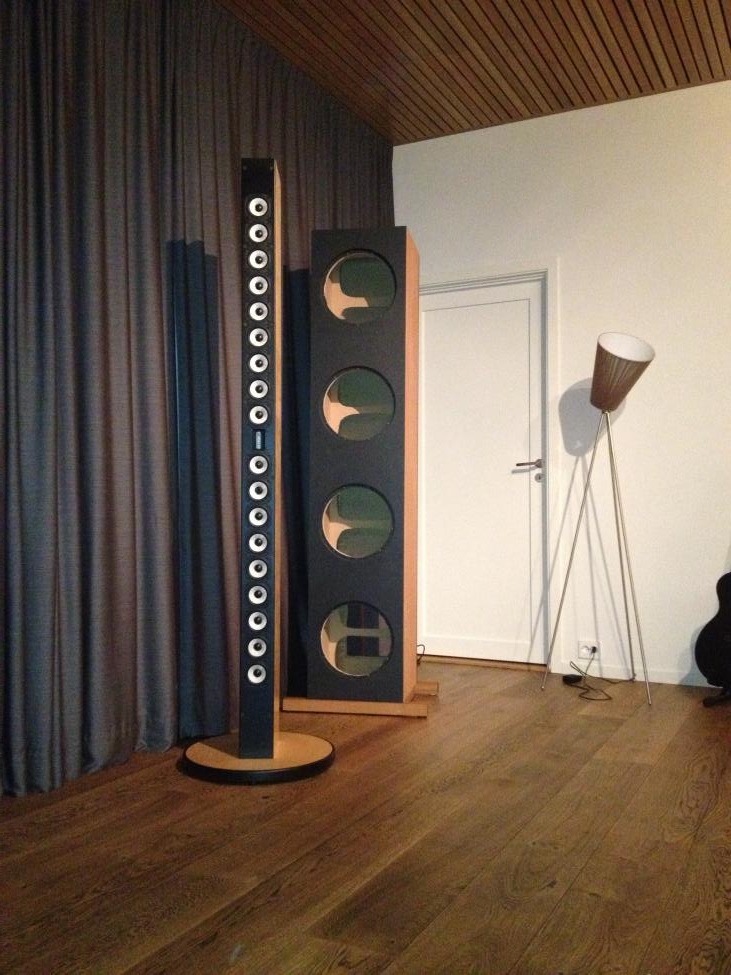
I kind of wonder, you don't use forced EQ down below, as there are a couple of big woofers to cover that. Yet you did try and solve a problem where I'd imagine there is none?
Having so many of these little drivers in a row means they put out a lot of energy at that '500 and down' frequency range. Down to about 100 Hz there should not be any problem at all. At least that's what measurements with this driver's cheap sister driver, the TC9 has shown on more than one occasion. So I don't quite follow the why, as at about 250 Hz you'd have plenty of output (more than you'd need), being arrayed like this, without any of these drivers working up a sweat. Is the 4 Ohm TG9 really worse in that department than the (early) 8 ohm version used in the IDS or the sister TC9 driver?
I have never measured anything that worried me, distortion wise and I certainly do use a lot of EQ. But I do use the TC9 (8 ohm).
Technically, this thread should be in multi-way as there is clearly more than one way (there always is )
)
I kind of wonder, you don't use forced EQ down below, as there are a couple of big woofers to cover that. Yet you did try and solve a problem where I'd imagine there is none?
Having so many of these little drivers in a row means they put out a lot of energy at that '500 and down' frequency range. Down to about 100 Hz there should not be any problem at all. At least that's what measurements with this driver's cheap sister driver, the TC9 has shown on more than one occasion. So I don't quite follow the why, as at about 250 Hz you'd have plenty of output (more than you'd need), being arrayed like this, without any of these drivers working up a sweat. Is the 4 Ohm TG9 really worse in that department than the (early) 8 ohm version used in the IDS or the sister TC9 driver?
I have never measured anything that worried me, distortion wise and I certainly do use a lot of EQ. But I do use the TC9 (8 ohm).
Technically, this thread should be in multi-way as there is clearly more than one way (there always is
Attachments
Last edited:
Hi wilbur-x, awesome build !!
...a lot of the things you did make sense to me....
What are your crossover points, and their type/order?
How do you like the subs? Have you used the drivers in other builds?
And how well does the AMT blend in?
Hi wesayso, I think he addressed a problem where there really is one..
Yes, the 24 little drivers put out a lot of energy below 500hz, but not nearly enough down around 100hz to keep up with his subs.
Just multiplying Sd times x-max times 24 drivers still comes short in displacement terms, of just one strong 12" driver.
and it looks like wilbur-x is transitioning into two! killer 21" subs...
Plus the intermod can't be good when the little guys are near x-max.
Also, I have to say...anytime a driver needs more than a 6dB boost ..I really get the willies...I mean it's crazy looking at the high power draw of the TC9's compared to the combined draw of my 4-ways.
So, to me anyway, all makes very good sense
...a lot of the things you did make sense to me....
What are your crossover points, and their type/order?
How do you like the subs? Have you used the drivers in other builds?
And how well does the AMT blend in?
Hi wesayso, I think he addressed a problem where there really is one..
Yes, the 24 little drivers put out a lot of energy below 500hz, but not nearly enough down around 100hz to keep up with his subs.
Just multiplying Sd times x-max times 24 drivers still comes short in displacement terms, of just one strong 12" driver.
and it looks like wilbur-x is transitioning into two! killer 21" subs...
Plus the intermod can't be good when the little guys are near x-max.
Also, I have to say...anytime a driver needs more than a 6dB boost ..I really get the willies...I mean it's crazy looking at the high power draw of the TC9's compared to the combined draw of my 4-ways.
So, to me anyway, all makes very good sense
At 200 Hz these little babies can rip your head off without breaking a sweat. You don't need more than an array staying well within x-max for that.
Below that, sure... but that has been covered here. Around 250 Hz he'll have about 10 dB more output than at 2500 Hz. No EQ boost needed for that.
6 dB of boost divided bij 24 drivers is how much for each driver exactly?
They eat watts for lunch without getting past x-max. About 240 watt for 25 drivers in series/parallel. Which at 250 Hz is way more SPL than what is needed.
I'm not worried , not for what is asked of these little ones here.
, not for what is asked of these little ones here.
Now if you (have to) boost the low end, things will be a little different.
P.s. do the math, they come out like a 12 inch with about 7mm x-max. Not having to cover the low frequencies, they will hardly move.
Now if one would array the Scan Speak 10F, you'd only need 70 watt to achieve the same numbers. That would also rip off your head, in practice you'd need just a fraction of that.
Below that, sure... but that has been covered here. Around 250 Hz he'll have about 10 dB more output than at 2500 Hz. No EQ boost needed for that.
6 dB of boost divided bij 24 drivers is how much for each driver exactly?
They eat watts for lunch without getting past x-max. About 240 watt for 25 drivers in series/parallel. Which at 250 Hz is way more SPL than what is needed.
I'm not worried
Now if you (have to) boost the low end, things will be a little different.
P.s. do the math, they come out like a 12 inch with about 7mm x-max. Not having to cover the low frequencies, they will hardly move.
Now if one would array the Scan Speak 10F, you'd only need 70 watt to achieve the same numbers. That would also rip off your head, in practice you'd need just a fraction of that.
Last edited:
At 200 Hz these little babies can rip your head off without breaking a sweat. You don't need more than an array staying well within x-max for that.
Below that, sure... but that has been covered here. Around 250 Hz he'll have about 10 dB more output than at 2500 Hz. No EQ boost needed for that.
6 dB of boost divided bij 24 drivers is how much for each driver exactly?
They eat watts for lunch without getting past x-max. About 240 watt for 25 drivers in series/parallel. Which at 250 Hz is way more SPL than what is needed.
I'm not worried, not for what is asked of these little ones here.
Now if you (have to) boost the low end, things will be a little different.
P.s. do the math, they come out at a 12 inch with about 7mm x-max. Not having to cover the low frequencies. They will hardly move.
I guess there are different definitions of what will rip our heads off
Or on how much bottom end we prefer
I've found my 24 TC9 arrays cannot keep up, high passed at the 100Hz cross over point I typically use with my subs.
They hit x-max even at that xover point where they still need some attenuation , not some boost.
That's part of why i say that what wilbur-x has done makes good sense to to me.
And if used full range, what ever +6 dB or more boost we apply to the TC9's, goes fully into each and every driver, ...it's not divided among drivers......... I don't get how you say it can be divided ?????
Pls correct my math if in error:
24 TC9 (drivers) x 36.3 (sd) x 2.6 (x-max) = 2265 (displacement)
1 (12") x 530 (sd) x 7 (x-max) = 3710 (displacement)
You know like i said in opening, I think this type discussion comes down to how dynamic do you like your sound, with how much bass support.
Was that for indoors? 
I don't know what volume you're using or what you're after, but I don't want to be in the room with you.
The 6 dB, translates to 4 watt compared to 1 watt, right? Doubling the power for each dB.
Let's fire up xsim and see, sorry, I used 25 drivers in series parallel because that's what I have in my library.
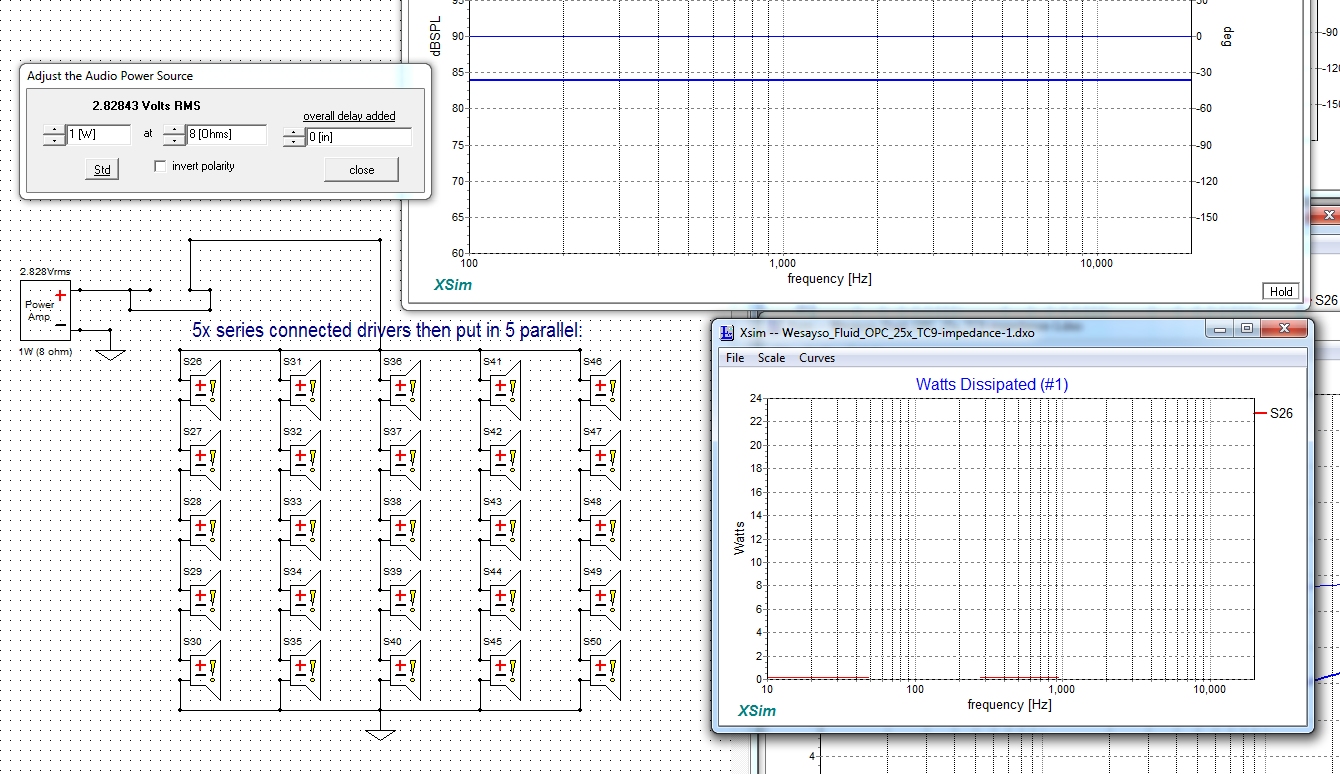
One watt, and the graph for a single driver in that array showing watts dissipated for that driver. Even though the graph says 84 dB for an array of drivers, the array behavior will add about 13 dB at ~200 Hz. At 1 watt it will be close to 97 dB/watt at 300 Hz. Dropping output potential below Fs of course. And dropping 3 dB per octave above that.
Now let's pump up the volume, putting in 4 watt for that 6 dB in gain:
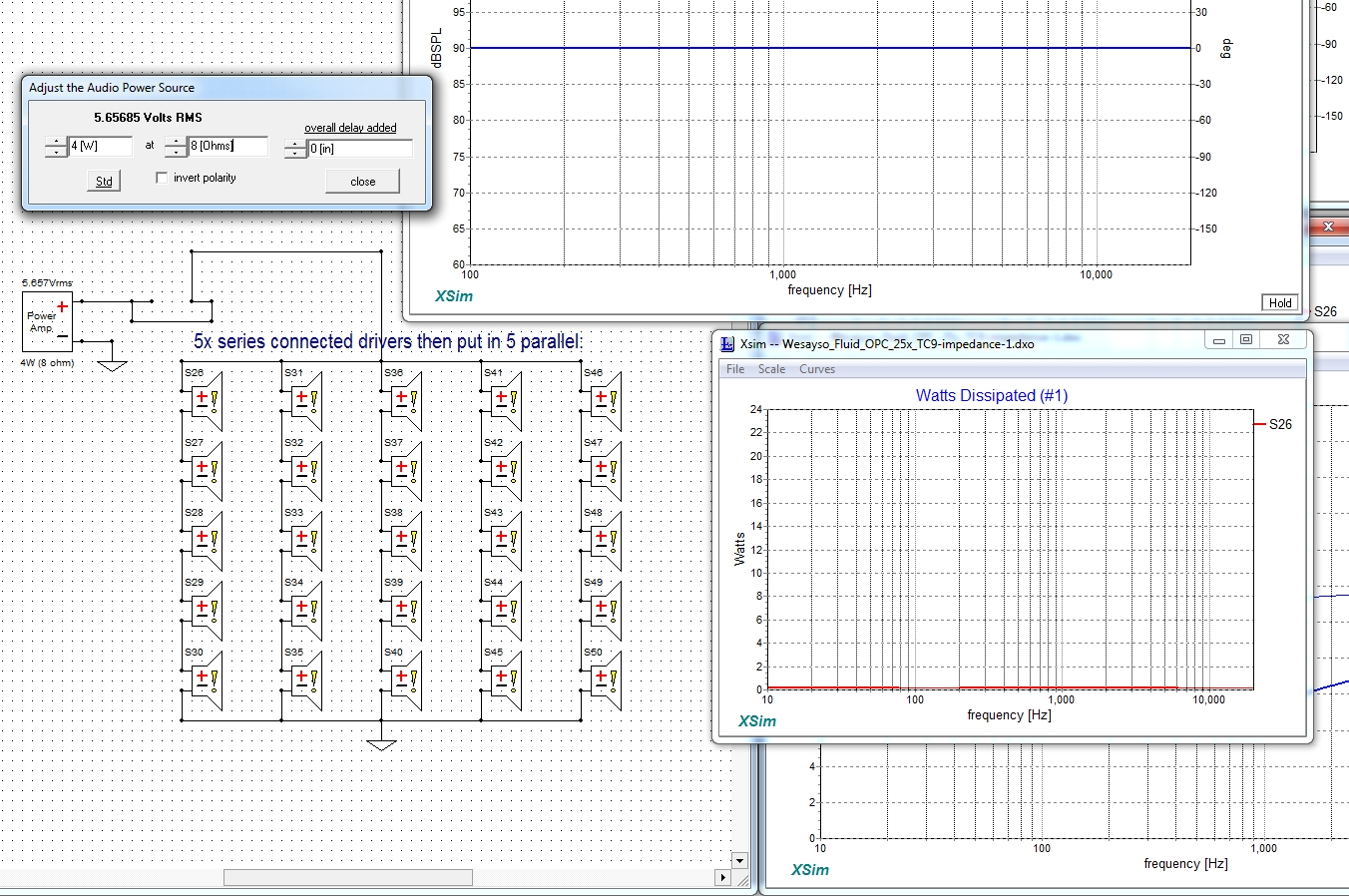
Still barely visible what one driver gets, hence my comment about spreading the load between the drivers.
Let's pump it up, putting in 240 watt, like I claimed it could handle:
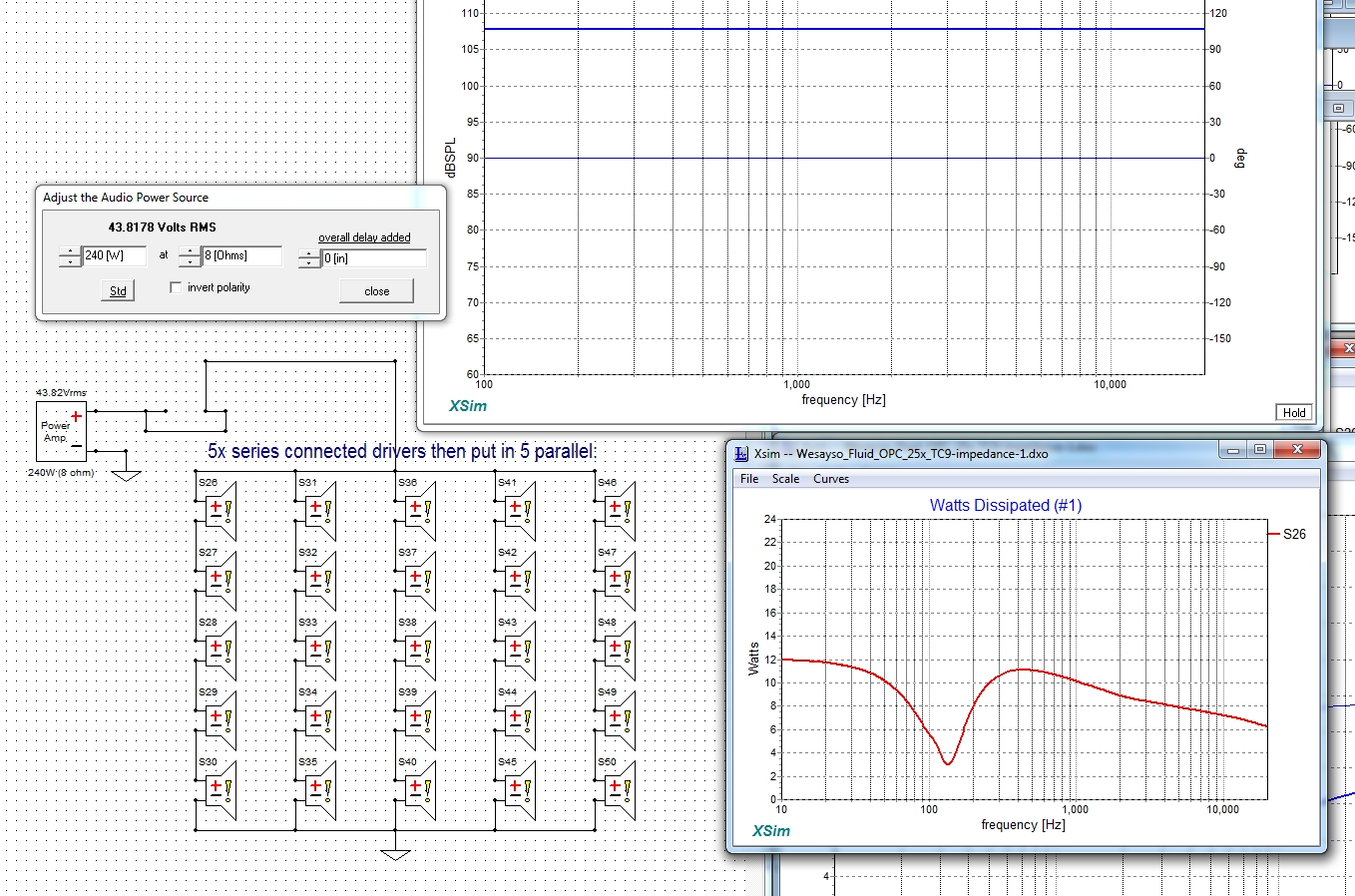
Each driver still get's a fraction of that, in this case: 8 watt at 200 Hz, 10.25 watt at 300 Hz etc. Depending on what version of the countless spec sheets you've got it is advertised as a 30 watt noise power handling per driver,
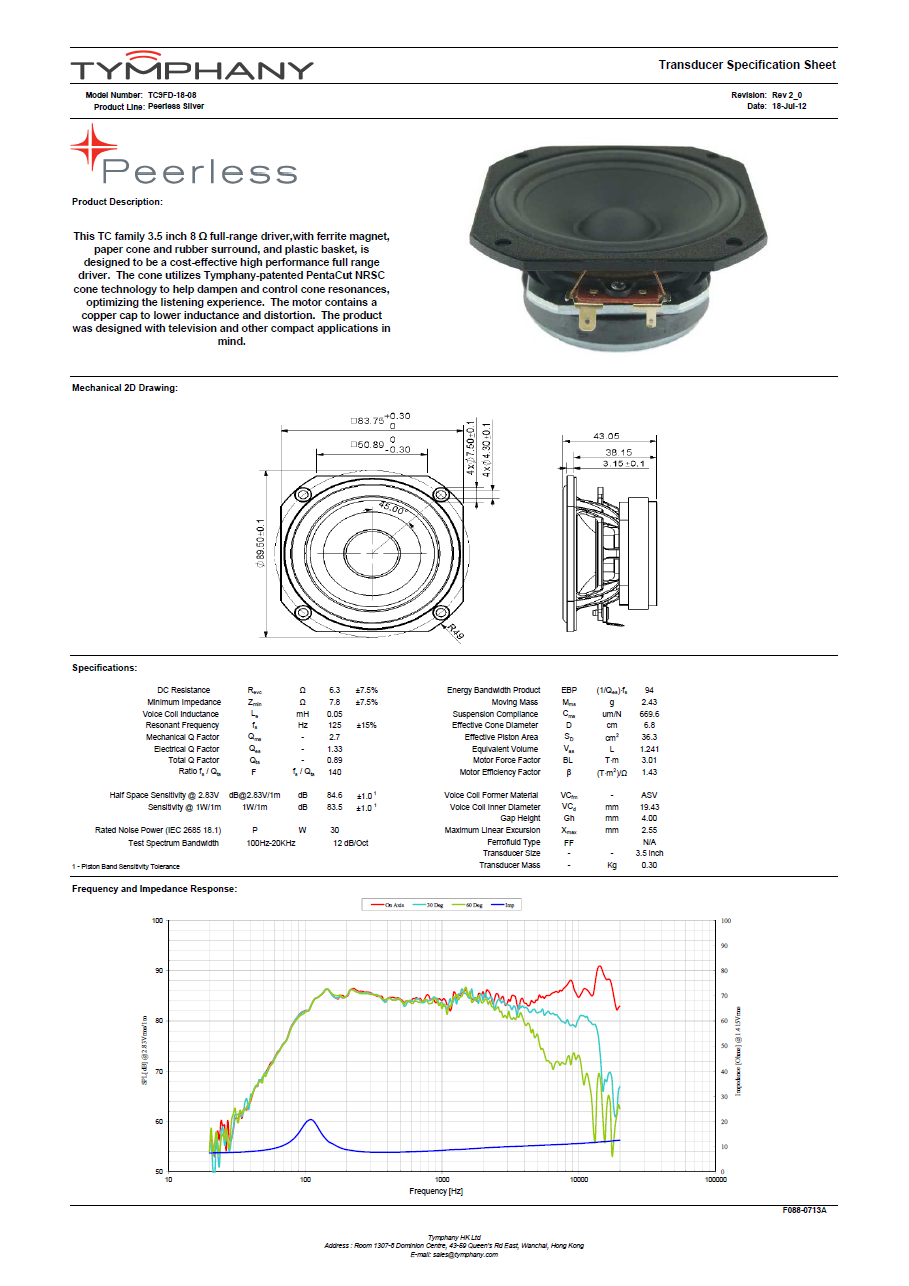
50 watt in rev1:
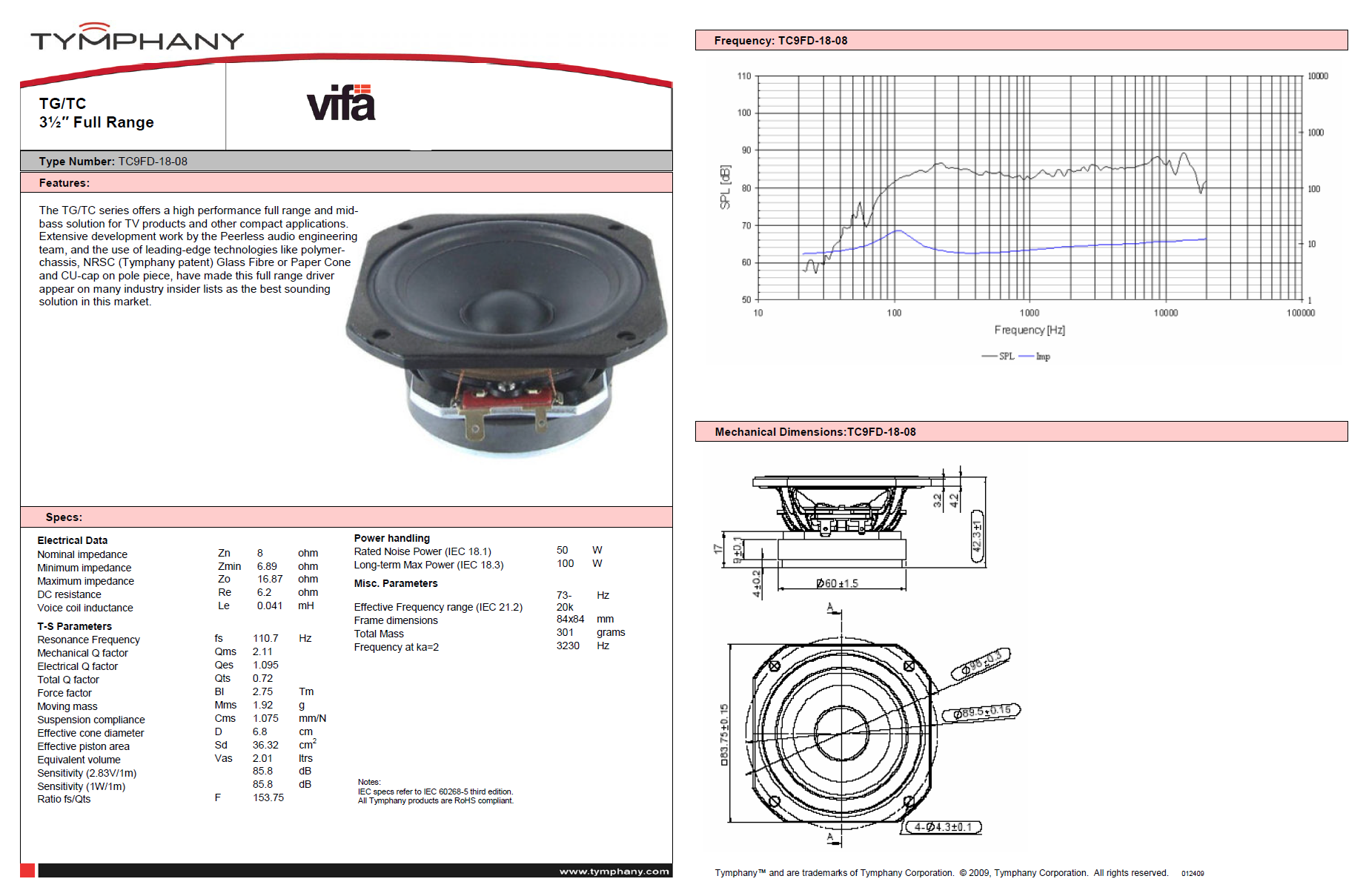
But I've always used 15 watt myself, due to wanting to keep things in one piece while boosting the low end.
The scale says it hits 107 dB, the array behavior will add the 13 dB to that, making it ~120 dB at 200 Hz, and falling off 3 dB each octave above that, where the watts dissipated drop down.
I could have figured you'd pick a healthy 12" driver. I have the Scan Speak 30W with 466 cm3.
Did you connect the drivers in parallel/series? Because I've never checked watts dissipated for that scenario . You could be right in that case.
. You could be right in that case.
So maybe this was a gross oversight from my side, thinking I had to rewire to parallel series because of the better behavior/handling at Fs? Is that connection scheme handling the total amount of power in each and every single driver of that array? It would/could explain why you ran into x-max very soon... I honestly never did that math(!) However I would think anyone building it like that would bother to check. I've literary run dozens of sims for my arrays.
Let's check it now:
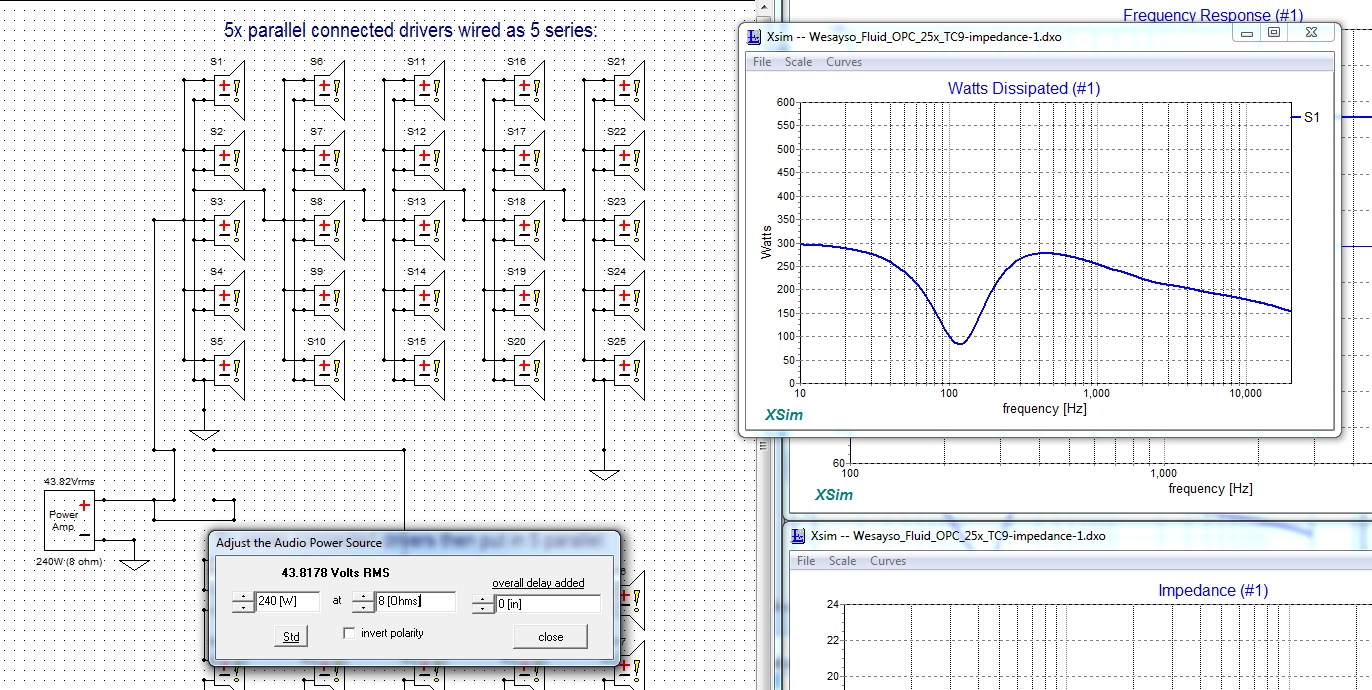
25 drivers in parallel/series with 240 watt, one driver gets the full amount!
That would explain a great deal . It also puts an end to my personal rewiring dreams
. It also puts an end to my personal rewiring dreams  . (I have to say, I'm pretty sure I would have checked this in advance before rewiring)
. (I have to say, I'm pretty sure I would have checked this in advance before rewiring)
I have learned something new today, for that I do thank you. But I feel ashamed/stupid I've never checked this before. Why didn't anyone else ever check this and correct me? For all the times I promoted the wrong schematics? I'll copy and paste this in my thread as a warning!
I don't know what volume you're using or what you're after, but I don't want to be in the room with you.
The 6 dB, translates to 4 watt compared to 1 watt, right? Doubling the power for each dB.
Let's fire up xsim and see, sorry, I used 25 drivers in series parallel because that's what I have in my library.
One watt, and the graph for a single driver in that array showing watts dissipated for that driver. Even though the graph says 84 dB for an array of drivers, the array behavior will add about 13 dB at ~200 Hz. At 1 watt it will be close to 97 dB/watt at 300 Hz. Dropping output potential below Fs of course. And dropping 3 dB per octave above that.
Now let's pump up the volume, putting in 4 watt for that 6 dB in gain:
Still barely visible what one driver gets, hence my comment about spreading the load between the drivers.
Let's pump it up, putting in 240 watt, like I claimed it could handle:
Each driver still get's a fraction of that, in this case: 8 watt at 200 Hz, 10.25 watt at 300 Hz etc. Depending on what version of the countless spec sheets you've got it is advertised as a 30 watt noise power handling per driver,
50 watt in rev1:
But I've always used 15 watt myself, due to wanting to keep things in one piece while boosting the low end.
The scale says it hits 107 dB, the array behavior will add the 13 dB to that, making it ~120 dB at 200 Hz, and falling off 3 dB each octave above that, where the watts dissipated drop down.
I could have figured you'd pick a healthy 12" driver. I have the Scan Speak 30W with 466 cm3.
Did you connect the drivers in parallel/series? Because I've never checked watts dissipated for that scenario
So maybe this was a gross oversight from my side, thinking I had to rewire to parallel series because of the better behavior/handling at Fs? Is that connection scheme handling the total amount of power in each and every single driver of that array? It would/could explain why you ran into x-max very soon... I honestly never did that math(!) However I would think anyone building it like that would bother to check. I've literary run dozens of sims for my arrays.
Let's check it now:
25 drivers in parallel/series with 240 watt, one driver gets the full amount!
That would explain a great deal
I have learned something new today, for that I do thank you. But I feel ashamed/stupid I've never checked this before. Why didn't anyone else ever check this and correct me? For all the times I promoted the wrong schematics? I'll copy and paste this in my thread as a warning!
Attachments
I am not sure what went wrong in your sim of this , and I have not yet gone through the schematics of the two situations, but your conclusion is wrong!!Was that for indoors?
I don't know what volume you're using or what you're after, but I don't want to be in the room with you.
The 6 dB, translates to 4 watt compared to 1 watt, right? Doubling the power for each dB.
Let's fire up xsim and see, sorry, I used 25 drivers in series parallel because that's what I have in my library.
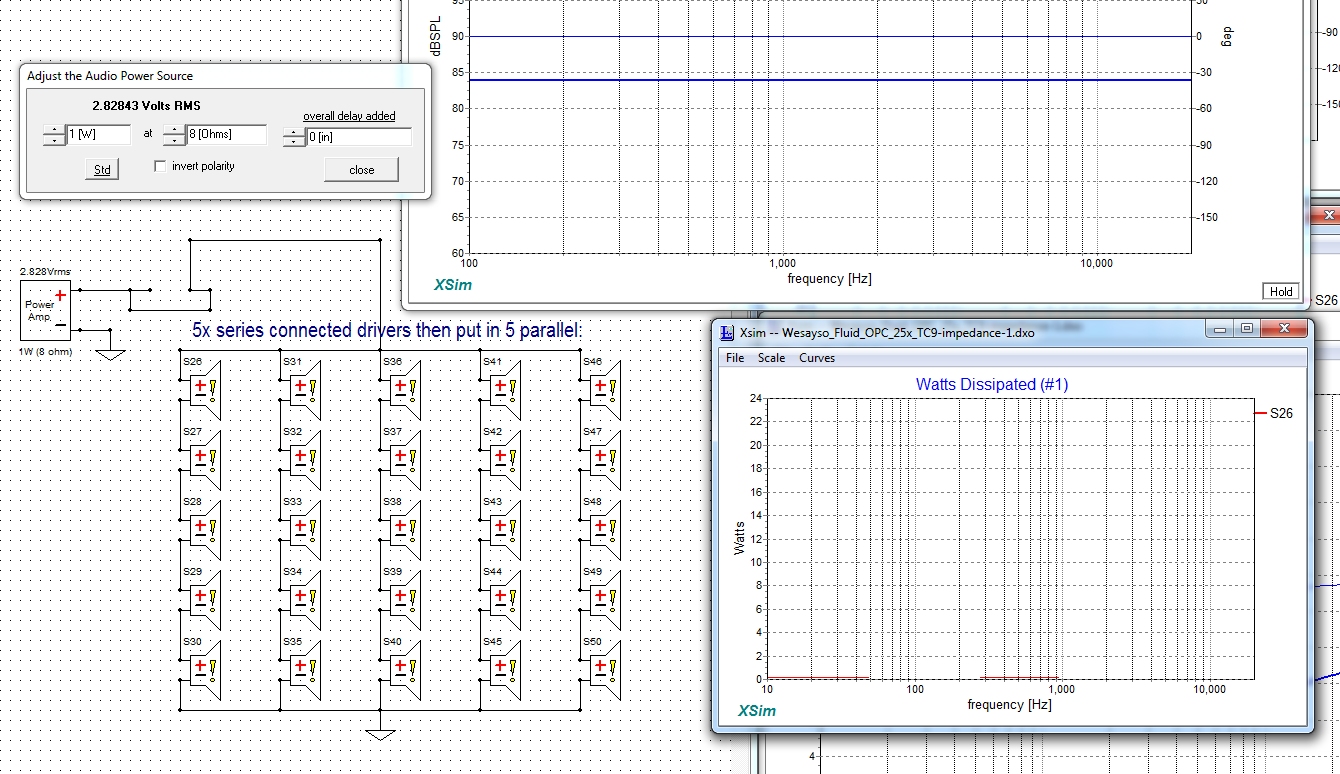
One watt, and the graph for a single driver in that array showing watts dissipated for that driver. Even though the graph says 84 dB for an array of drivers, the array behavior will add about 13 dB at ~200 Hz. At 1 watt it will be close to 97 dB/watt at 300 Hz. Dropping output potential below Fs of course. And dropping 3 dB per octave above that.
Now let's pump up the volume, putting in 4 watt for that 6 dB in gain:
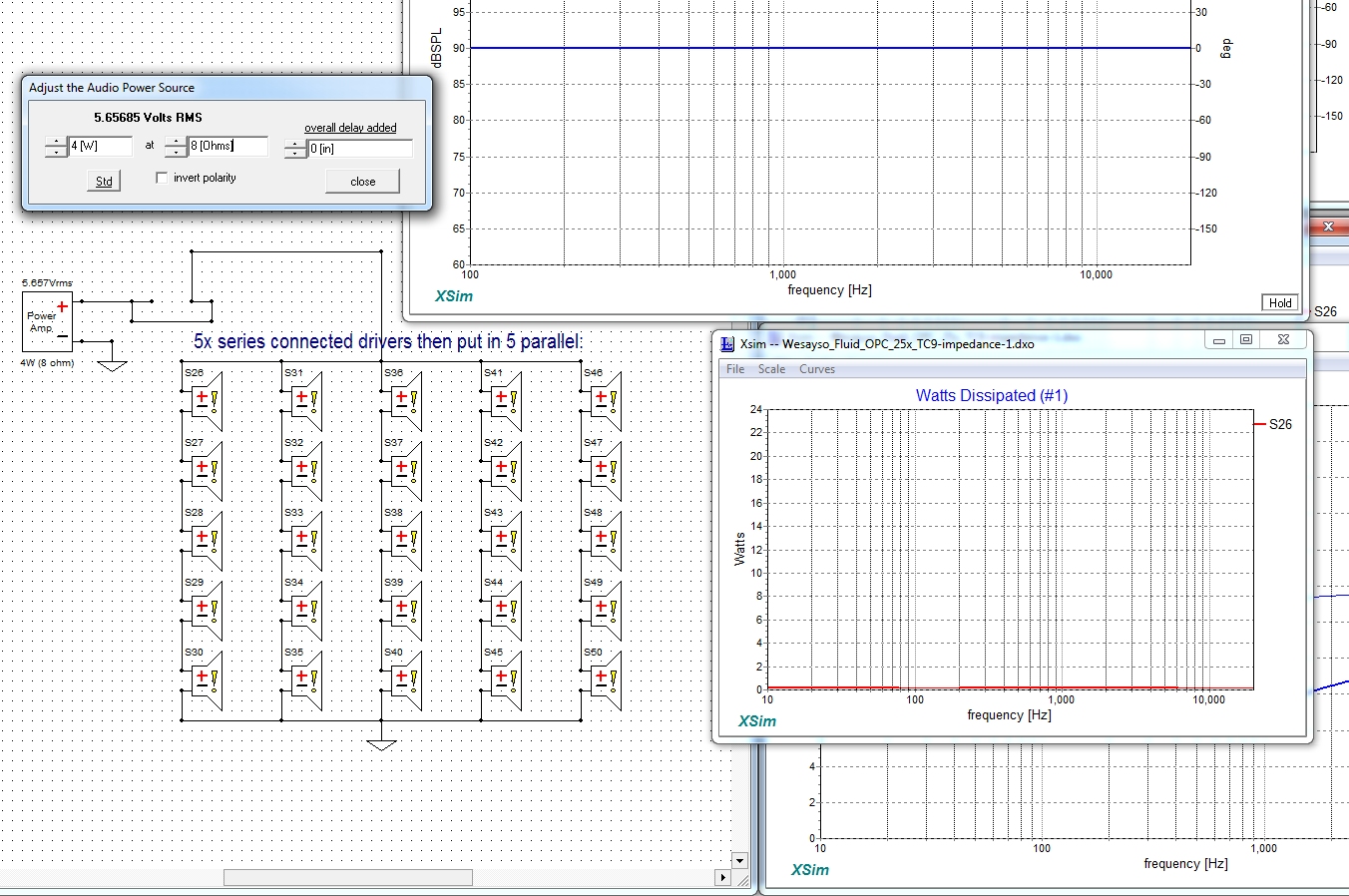
Still barely visible what one driver gets, hence my comment about spreading the load between the drivers.
Let's pump it up, putting in 240 watt, like I claimed it could handle:
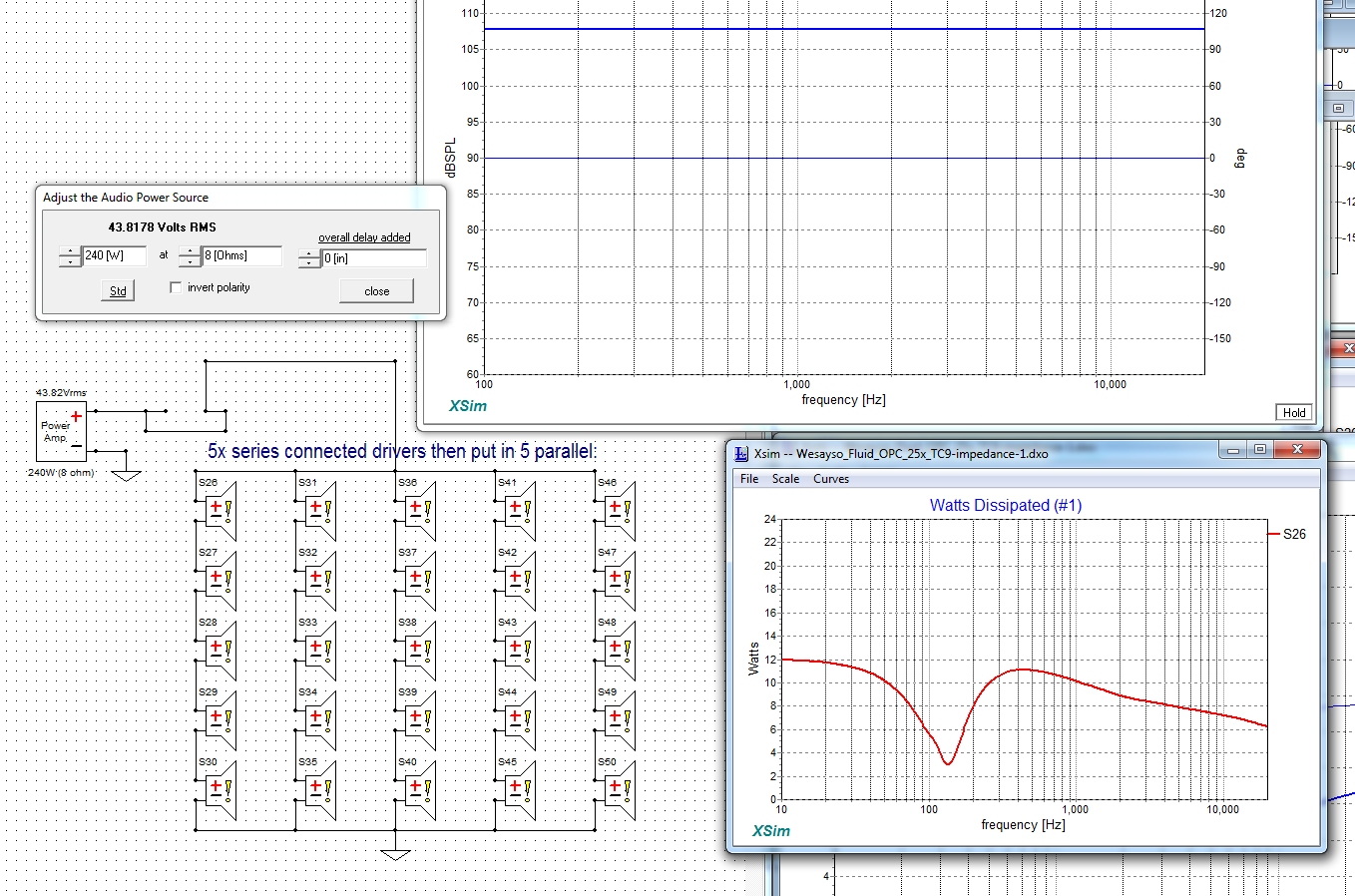
Each driver still get's a fraction of that, in this case: 8 watt at 200 Hz, 10.25 watt at 300 Hz etc. Depending on what version of the countless spec sheets you've got it is advertised as a 30 watt noise power handling per driver,
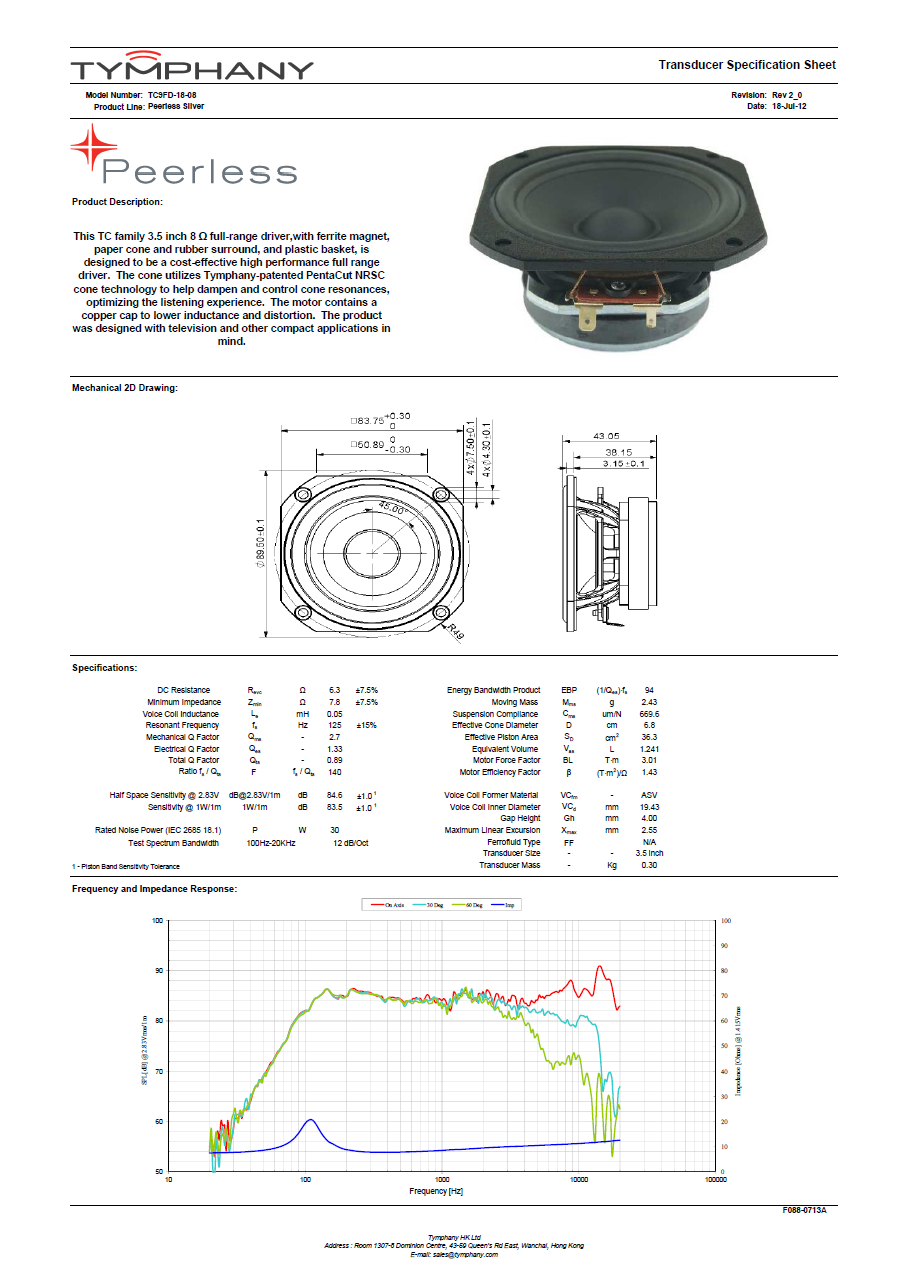
50 watt in rev1:
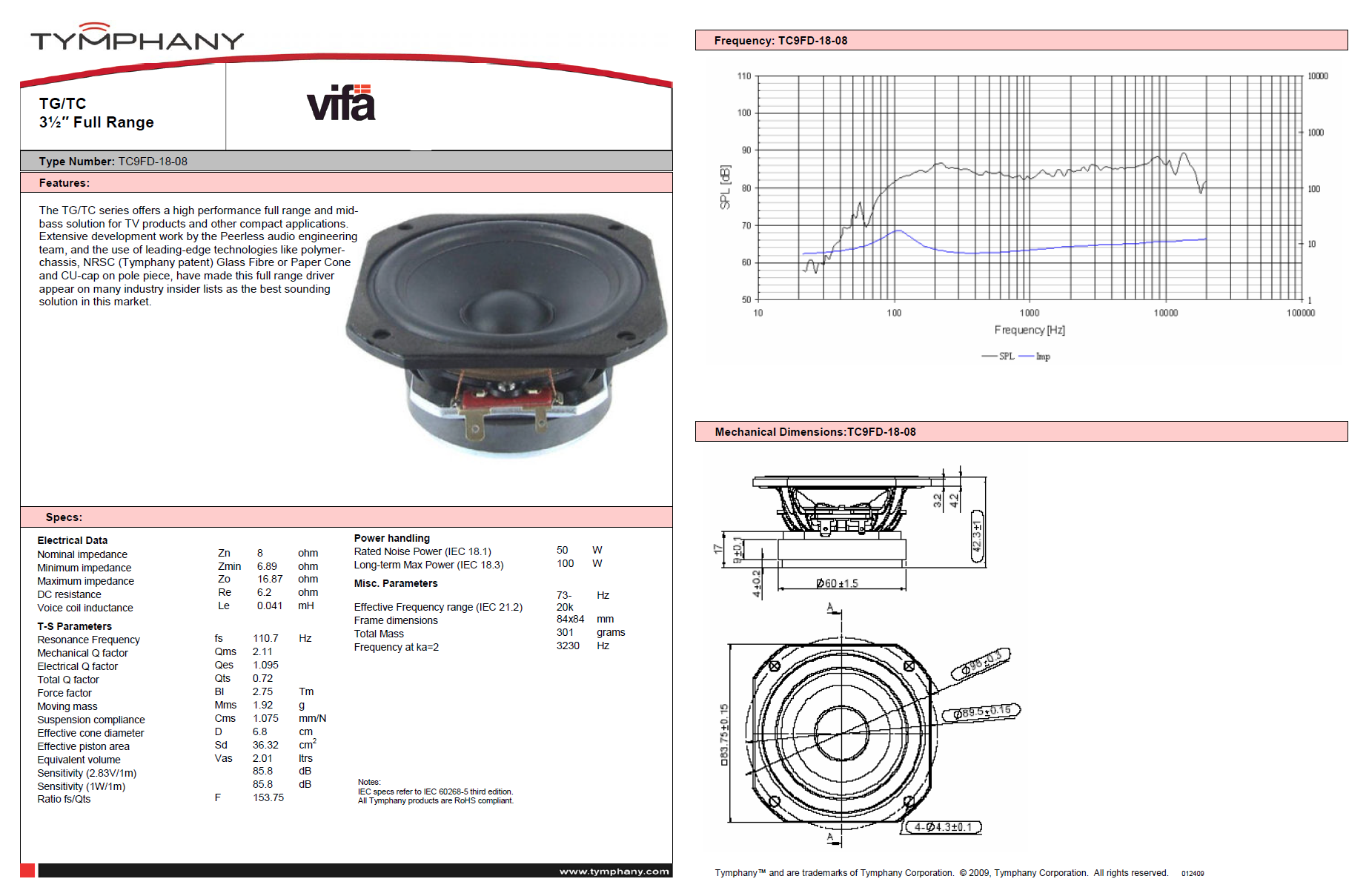
But I've always used 15 watt myself, due to wanting to keep things in one piece while boosting the low end.
The scale says it hits 107 dB, the array behavior will add the 13 dB to that, making it ~120 dB at 200 Hz, and falling off 3 dB each octave above that, where the watts dissipated drop down.
I could have figured you'd pick a healthy 12" driver. I have the Scan Speak 30W with 466 cm3.
Did you connect the drivers in parallel/series? Because I've never checked watts dissipated for that scenario. You could be right in that case.
So maybe this was a gross oversight from my side, thinking I had to rewire to parallel series because of the better behavior/handling at Fs? Is that connection scheme handling the total amount of power in each and every single driver of that array? It would/could explain why you ran into x-max very soon... I honestly never did that math(!) However I would think anyone building it like that would bother to check. I've literary run dozens of sims for my arrays.
Let's check it now:
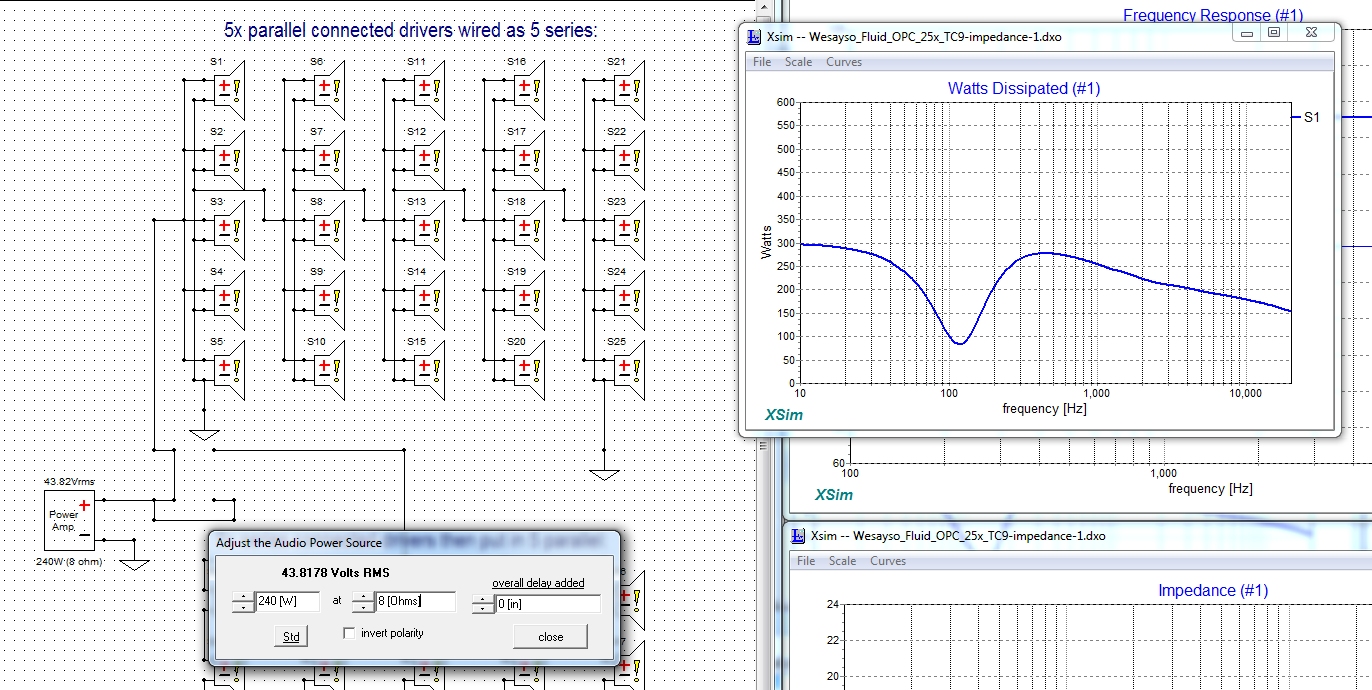
25 drivers in parallel/series with 240 watt, one driver gets the full amount!
That would explain a great deal. It also puts an end to my personal rewiring dreams
. (I have to say, I'm pretty sure I would have checked this in advance before rewiring)
I have learned something new today, for that I do thank you. But I feel ashamed/stupid I've never checked this before. Why didn't anyone else ever check this and correct me? For all the times I promoted the wrong schematics? I'll copy and paste this in my thread as a warning!
No matter how you wire them parallel/series or series/parallel each of the speakers will get 1/25 of the total power you present at the total array.
When I look at such problems I always try to take a simple example to show how it works. 4 resistors can be put in parallel/series or in series/parallel and this shows what happens. Dosent matter how many you are dealing with, the situation will be the same. This is Ohms Law and no sim software is going to change that IMHO
Attachments
That's what I have always figured as well.
It should not matter... I just picked the schematic that Byrtt made and typed in the power numbers. But theory is that these drivers do share the load, right? Or something must be wrong, like in my quick example.
I may have done something wrong in the schematic, as I have used that for other purposes.
It should not matter... I just picked the schematic that Byrtt made and typed in the power numbers. But theory is that these drivers do share the load, right? Or something must be wrong, like in my quick example.
I may have done something wrong in the schematic, as I have used that for other purposes.
Let's check it now:

Hi wesayso, koldby is right.
Series/parallel or parallel/series makes no difference.
All that matters with regards to equal power dissipation is that the voltage to each driver, in whatever wiring scheme used, remains the same to each driver.
I highly recommend ditching thinking in terms of watts, and working with voltage....
It looks like you need to remove the ground from the left side column of drivers in your sim...that should fix things..if I understand the sim correctly..
Yes, my listening to the arrays' over-excursion was indoors.
The thing is, we can't just ignore below 250Hz.
I mean what value is there to getting loud in one frequency region if the speaker can't maintain the SPL throughout the spectrum?
So what was it about each driver seeing the 6 dB boost? That doesn't happen, does it?
Yes, sure it does. When you raise speaker SPL by 6dB, you raise the drive signal by 6 dB to each and every driver.
Or said equivalently, doubling the amplifier output voltage, doubles the voltage to each and every driver. (and happens to be 6 dB)
I have amps that monitor rms and peak voltages to each channel, as well as showing wattage.
It's clear that the boost necessary to use the TC9 arrays as a full range speaker pushes the drivers to the edge, before what I would call loud listening levels. Strong transients can bottom out the drivers.
So I'm trying the arrays with a sub...much better, but still a long way from what a single 12" rcf can do in the 100Hz to 200 Hz area...particularly with regards to transients.
But that doesn't mean I'm unhappy with the arrays...I'm quite happy with their really nice midrange and dispersion pattern. And I didn't build them to rock my house.
It just means that i can totally understand why guys would want to build designs like wilbur-x has..
It's clear that the boost necessary to use the TC9 arrays as a full range speaker pushes the drivers to the edge, before what I would call loud listening levels. Strong transients can bottom out the drivers.
So I'm trying the arrays with a sub...much better, but still a long way from what a single 12" rcf can do in the 100Hz to 200 Hz area...particularly with regards to transients.
But that doesn't mean I'm unhappy with the arrays...I'm quite happy with their really nice midrange and dispersion pattern. And I didn't build them to rock my house.
It just means that i can totally understand why guys would want to build designs like wilbur-x has..
I agree with Wesayso,
If you roll off the arrays @ 100Hz you must play at EXTREEMELY loud levels if you feel you are missing SPL from the arrays..
I play them in a 60 sqm big room and they will hurt my ears before they run out of steam > 100 Hz.
It's not the average SPL that's the issue for me...they are probably loud enough above 100Hz for that. It's the dynamics, and rising distortion when driven harder.
That's a nice sized room ! Do you use subs?
No but I am planning to do it . I am only compensating them to mid 30 Hz now or I have to give up too much in spl. The arrays are very dynamic and have great transient behavior. Certainly they do not sound as a 12" Pro unit, but that is IMHO because the 12" is coloring the music.It's not the average SPL that's the issue for me...they are probably loud enough above 100Hz for that. It's the dynamics, and rising distortion when driven harder.
That's a nice sized room ! Do you use subs?
Thank you very much for feedback guys 
I really like Wesaysos columns, one of many fine designs out there.
I did not introduce a problem with subs either? I use subs as I got a more flexible solution. I do not need to force the Vifas much under their resonance. An interesting possibility is testing out releasing the Vifas from distortion & Doppler by introducing a high pass for power amp as Troels describes here. The Vifas already got reduced low end distortion due to 5th. elements mod with phase plug.
I also have the opportunity to use the subs for other systems, play without subs, move the towers without much variation re. woofer capacity (under Schroeder), shake the neighborhood, sell the subs etc.
Regarding Adyton: Yes, Adytons are really fine and good sounding speakers, made by an old friend of mine. He also make the Audio Insight speakers and amps (check them out). Adytons have rectangular cross section, mine are trapezoidal like IDS, but with separate chamber for each driver. I think all column speakers got their grandfathers and mutants.
A really old column is the University Sound Model CSO-6.
Anyway, I did it my way (sing along).
Crossover points: I start with 100 hz and 3500-4000 where the Vifa start the 30 & 60 degree downwards slope. I'm not finished with tuning yet as one amp had a breakdown.
The woofers are used in former Midgard Audio Centurion subs .
They got glorious reviews, so I made my choice when 4 of the 21" drivers appeared for sale on a swap meet.
My woofer cabinets are specified by Midgards Audios engineer.
Spin-offs: What if... (should would could, may etc)...
Introducing a backfire tweeter w/ attenuator.
Introducing a 25th Vifa on one side at tweeter compartment on each column, separate connected to an integrated amp, but with reverse channel and phase (ref. Polk Hologram)
I really like Wesaysos columns, one of many fine designs out there.
I did not introduce a problem with subs either? I use subs as I got a more flexible solution. I do not need to force the Vifas much under their resonance. An interesting possibility is testing out releasing the Vifas from distortion & Doppler by introducing a high pass for power amp as Troels describes here. The Vifas already got reduced low end distortion due to 5th. elements mod with phase plug.
I also have the opportunity to use the subs for other systems, play without subs, move the towers without much variation re. woofer capacity (under Schroeder), shake the neighborhood, sell the subs etc.
Regarding Adyton: Yes, Adytons are really fine and good sounding speakers, made by an old friend of mine. He also make the Audio Insight speakers and amps (check them out). Adytons have rectangular cross section, mine are trapezoidal like IDS, but with separate chamber for each driver. I think all column speakers got their grandfathers and mutants.
A really old column is the University Sound Model CSO-6.
Anyway, I did it my way (sing along).
Crossover points: I start with 100 hz and 3500-4000 where the Vifa start the 30 & 60 degree downwards slope. I'm not finished with tuning yet as one amp had a breakdown.
The woofers are used in former Midgard Audio Centurion subs .
They got glorious reviews, so I made my choice when 4 of the 21" drivers appeared for sale on a swap meet.
My woofer cabinets are specified by Midgards Audios engineer.
Spin-offs: What if... (should would could, may etc)...
Introducing a backfire tweeter w/ attenuator.
Introducing a 25th Vifa on one side at tweeter compartment on each column, separate connected to an integrated amp, but with reverse channel and phase (ref. Polk Hologram)
Last edited:
All I was really wondering about is why the mod on the drivers was needed with drivers that don't have to go down low.
But it would let you try it instead of using the big guns.
The big woofers is quite a good and solid solution if you ask me. .
.
I see you plan on running different solutions, you have lots of options this way! I hope you keep us posted how you do with both low en and upper end support.
I do like the visual end result. No way I would be allowed something similar though... I'm a bit jealous/envious .
.
But it would let you try it instead of using the big guns.
The big woofers is quite a good and solid solution if you ask me.
I see you plan on running different solutions, you have lots of options this way! I hope you keep us posted how you do with both low en and upper end support.
I do like the visual end result. No way I would be allowed something similar though... I'm a bit jealous/envious
I was convinced I had someone that could do my baffles with CNC. I ended up doing it by hand with simple tools, no fun!
I'm quite curious about the results if you end up using the Polk like cross talk compensation. I'd like to know what that does. Have you played with something like that before?
I'm quite curious about the results if you end up using the Polk like cross talk compensation. I'd like to know what that does. Have you played with something like that before?
- Status
- This old topic is closed. If you want to reopen this topic, contact a moderator using the "Report Post" button.
- Home
- Loudspeakers
- Full Range
- IDS-25 stalker:IDS-24T
